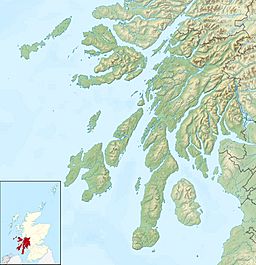Loch Striven facts for kids
Quick facts for kids Loch Striven |
|
|---|---|

Loch Striven at Inverchaolain.
|
|
| Location | Cowal, Argyll and Bute, Scotland. |
| Coordinates | 55°55′44″N 5°04′15″W / 55.928753°N 5.0707625°W, |
| Type | Sea Loch |
| Native name | Loch Sroigheann Error {{native name checker}}: parameter value is malformed (help) |
| Basin countries | Scotland, United Kingdom. |
| Max. length | 12 km (7.5 mi) |
| Surface elevation | Sea Level |
| Frozen | No |
Loch Striven (which is called Loch Sroigheann in Scottish Gaelic) is a sea loch in Scotland. It's a long, narrow arm of the sea that stretches inland from the Firth of Clyde. You can find it along the coast of the Cowal peninsula in Argyll and Bute.
This loch is about 12 kilometers (8 miles) long. It reaches north into the Cowal Peninsula, ending at a small village called Ardtaraig. The loch is just north of the Isle of Bute.
Making Electricity at Loch Striven
A special power station is located at the very end of Loch Striven, near Ardtaraig. This station makes electricity using the power of water. It's called a hydro-electric generating station.
Water from Loch Tarsan is sent through large pipes to this station. This project is known as the Striven Hydro-Electric Scheme. It's also sometimes called the Cowal Hydro-Electric Power Scheme.
Ships Resting in the Loch
Loch Striven is a very calm and sheltered place. Because of this, it has been used as a safe spot for large ships to stay when they are not being used. This happens during times when there isn't much shipping business.
For example, two large ships called MV Gastor and MV Nestor were kept here for 15 years. They were new LNG carriers (ships that carry liquid natural gas). They stayed in the loch from 1976 until 1992.
Later, from 2009 to 2010, a Danish shipping company named Maersk also used the loch. They kept some of their big cargo ships here for a while.
Loch Striven During World War II
The quiet, hidden parts of Loch Striven were very important during World War II. They looked a lot like the fjords (narrow inlets) in Norway. Because of this, the loch was used for training special small submarines. These were called X-craft or midget submarines.
The training was managed from a place called HMS Varbel. This was a fancy hotel in Port Bannatyne that the navy took over. It became the main headquarters for midget submarine operations. This included planning the attack on the huge German warship, the Tirpitz.
Ardtaraig House, at the head of Loch Striven, was also taken over by the navy. It became a second naval base for the midget submarines and was known as HMS Varbel II.
The loch was also the main testing area for a special bomb called "Highball." This was a smaller version of the famous "bouncing bomb" used by The Dambusters. The "Highball" bomb was designed to bounce across the water and hit ships.
More than 100 dummy (practice) bombs were dropped into Loch Striven. This happened between spring 1943 and autumn 1944. Airplanes like the Wellington and mostly Mosquitoes from RAF Turnberry were used for these tests.
In 2017, two of these practice bombs were found in the loch. One is now at the Brooklands Museum, and the other is at the de Havilland Aircraft Museum.




